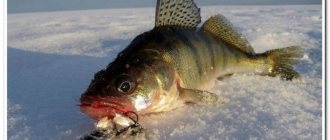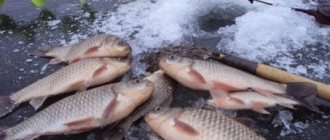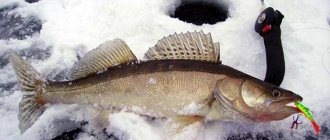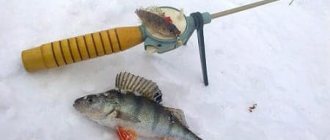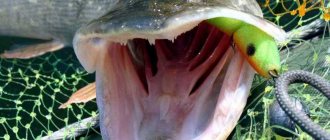Where to catch pike in November using a spinning rod
Cooling water forces peaceful fish, and then predators, to leave coastal waters. The predator stays in certain places and leaves them very rarely.
The pre-freeze period is good for pike fishing, when the frost has already arrived, but there is no ice yet. At this time, the pike bite on a spinning rod can be very active. The period is short-term and depends on the size of the reservoir. On small reservoirs without a current it is 1-2 days, on reservoirs 3–5 days, on large rivers – a week or more.
The locations for pike fishing with spinning rods in November are:
- deep-sea wintering pits far from the shore;
- thickets of deep-sea plants and snags;
- depths a little more than a meter (rare);
- holes at the confluence of rivers;
- holes, snags, fallen trees at the turns of steep banks;
- exits from reservoir bays into the riverbed;
- depth changes.
The choice of reservoir plays a huge role in successful fishing. They start fishing with spinning rods in November on small rivers and lakes, then comes the turn of medium-sized reservoirs. Lastly, they switch to fishing in large reservoirs and rivers that do not freeze for a long time, in which pike stick to depths of more than 5 meters.
Advice! In November, the pike does not need to look for food - food is collected in the same wintering pits where the predator stands, so having found a predator once, you can be sure that it will be there the next time.
Where to look for the November predator
To understand where to look for pike in November, you need to mentally imagine what is happening on the reservoir at that moment.
If in open water the feeding fish moved deeper and deeper, and the predator followed it, now, after the ice was established, all movement stopped.
Forage fish are located in the place where they will spend the entire winter. It moves to wintering pits while there is open water and while there is no ice. And the pike also stops in November.
Where to look for pike in November? On the deep parts of channel dumps, on their lower edges, on the lower slopes from irrigation holes.
In November you can look for pike on the edges of river islands, where they stand on the lower edges of sandy deep-sea spits.
In early November, pike is also often caught in deep reaches between two or three islands. Such reaches are formed by powerful river currents. And there, at a depth of 5-7 meters, the pike continues to feed in November, picking up wounded or sick roach or silver bream.
Pike fishing in November in such places will be the most productive. Next, it’s worth working on the question of how to catch pike in November, with what bait.
When to catch pike with a spinning rod in November
November is the harbinger of winter. In many regions, this is the month when ice sets in on water bodies. The behavior of pike this month is determined by weather conditions and time of day. The best weather for fishing is consistently cloudy without strong winds or pressure changes.
In November, unlike in summer, there are days when a sharp rise in pressure upwards with the simultaneous arrival of an anticyclone causes active pike biting on a spinning rod.
In most cases, the best time to catch pike with a spinning rod in November is early morning and late evening. However, there are no rules without exceptions - for inexplicable reasons, there is an active bite even in the middle of the day, especially in small bodies of water.
What to fish for in November?
This month, despite certain difficulties in terms of the techniques used and the search for the habitat of the toothy predator, provides the greatest possible selection of lures and baits. But still, experienced fishermen most often choose:
- Wobblers. You can take crankbaits, minnows, rattlins, bladeless walkers, fats and jerkbaits.
- Spoons, specifically spinners with a rounded blade and an angle of 45°. Size up to 4 cm. And, preferably, choose those models whose petal does not start playing too quickly.
- Vibrating tails and silicone are used from jigs. Length ranging from 10 to 15 cm.
- Also, this predator does not hesitate to attack dead fish in late autumn, so this type of bait can be used. This is due to the fact that this dish is on her “menu”.
- One feature to take into account is to choose larger bait models than for fishing in other seasons of the year.
Experienced fishermen recommend forgetting about live bait equipment in November. You should not check whether the pike is biting in this case, as this will still not bring a positive result.
Spinning for pike in November
To catch pike with a spinning rod at depths, large baits and heavy sinkers are used, so all components of the tackle must be appropriate. In turn, pike, on average, are caught much larger in November than in early autumn and summer.
Which spinning rod to choose for the shore and for the boat
The best spinning rod for autumn pike fishing would be a medium or medium-fast action. Medium action is used with braided fishing line, and medium-fast action is used with monofilament line. In this case, the fishing line or rod will dampen the jerking of the fish.
The rod test depends on the weight of the baits used. In small reservoirs, a test of up to 20 g is enough, and at greater depths of large rivers and lakes, even a test of 30 g may not be enough. When selecting a test rod, it is necessary to take into account that in November large baits are used, which themselves weigh quite a bit.
For coastal spinning fishing, rods with a length of 2.7 m are used, for fishing from a boat with a length of 2.2 m.
Reel, line, leash
For catching large pike with a spinning rod, the best option would be a medium-class spinning reel with a size of 3000 or more. To work with large weights of bait, it is desirable to have at least 5 bearings that can protect the reel from rapid destruction.
It is possible to use a multiplier reel, but it is much more expensive and has only one advantage over a spinning reel - it can work for a long time without breakdowns with large weights.
In clear, cold water, the line should be as inconspicuous as possible. For pike fishing, both monofilament and braided fishing lines are used. For fishing using a jig and a retractable leash, braided line is better suited - it is more sensitive when tapping the bottom. The diameter of the monofilament line is 0.25-0.3 mm, braided - 0.12-0.14 mm.
The leashes are soft, made of tungsten. The clasps on the leashes are small but strong. A 0.3-0.4 mm fluorocarbon line is perfect for a retractable leash.
Winter sparkle
The pike bite on the first ice, despite the seasonal peak of activity, is not constant. At one time it is better to take on live fish, in other conditions - on artificial bait. In addition to girders, you can successfully catch toothy fish during this period using vertical lures. For this, standard winter baits are used - spoons, balancers or ratlins.
Spoons
The good old spinner often shows itself in skillful hands better than newfangled balancers and ratlins. Typically, an angler uses one medium or powerful caliber tackle, adjusted to a certain weight of the bait. During the experiment, any bait, including balancers and winter wobblers, is suspended on one fishing rod on a 0.25-0.3 mm fishing line with a leash.
Unlike pike perch, pike prefers a gliding and slow game, with long pauses of about 10 seconds at the bottom fishing point. Not only winter vertical lures work for pike, but also regular summer oscillating lures, since they have just the right game during the vertical retrieve. These are wobbler or atom shaped pieces of iron familiar to all spinning anglers. When playing, they deviate far to the side and plan downward, making oscillatory movements. More information about winter lures for pike:
Balancers
In the first ice conditions, balancers of medium and large sizes also work toothily. During this period, balancers of bright, provocative colors - crimson, orange or perch - perform well. However, on some reservoirs the toothy fish takes only neutral and natural colors of bait. Pike requires a special game, different from the uniform perch or zander oscillations and twitches. Read more about fishing for pike on first ice using balancers and spinners
Ratlins
The latest newfangled volumetric lures - ratlins (vibes), which are essentially winter wobblers, also perform well. However, not all models work on pike from ice. To fish with vibes, you need to understand the intricacies of wiring and types of baits. Each vibe requires an individual approach and its own style of fishing. Once mastered, fishing with ratlins helps out when other baits don’t work. Article about catching pike with rattlins:
https://podlednik.ru/lovlya_zimoj/khishhniki/shhuka-na-ratliny
Lures for pike in November
Most often in November, pike bite from the bottom. Therefore, it is necessary to use bottom baits for fishing, which are selected according to the depth of the reservoir. But what is the best way to catch pike in November:
- Oscillating spinners.
- Wobblers.
- Silicone and “edible rubber”.
- Dead fish.
Advice! Preference should be given to baits of at least 8 cm - in November, pike prefers to catch one large fish, instead of chasing several small ones.
The best lures for pike in November
The best spinners for catching pike in November with a spinning rod are medium and large oscillating spinners. Spinner baits such as castmaster work great at great depths. The good old Atom, as well as Williams and KuusamoProfessor spinners, show good results.
Read also: The best lures for pike
Most often, bites occur on silver-colored spinners or mixtures of colors with “silver.”
We must not forget that in addition to its movement, the spinner attracts pike with acoustic waves. An excellent option is double ringing vibrators.
Wobblers for pike in November
Most often in November, sinking or neutral wobblers are used. For fishing at depths of up to 5-6 m, “minos” with a working depth exceeding a meter are used. To ensure a confident dive and give the ability to work at the very bottom, the wobbler is loaded with a “Cheburashka”, and the wiring is used in steps.
Read also: Catching pike with a wobbler
There are times when topwater lures work great. The best wobbler among them is Duel 3D Popper. A good option for deep fishing is the Rapala Husky Jerk.
For trolling, the largest wobblers are used - from 12 cm and jackbaits. The main requirement is great depth. Almost all bites at the end of autumn occur at the bottom.
Silicone and edible rubber
Silicone spinning baits in November, especially if the first frosts have appeared, often lose their effectiveness on small rivers and lakes. Biting on rubber continues on large rivers, lakes and reservoirs, especially at great depths. On such reservoirs, a large jig is bait No. 1. Foam fish and mandules are also used for pike hunting in November.
The color of the bait can play a decisive role. Very often these are the brightest colors - “acid colors”.
Catching pike in November with live bait and dead fish.
Live bait or dead fish work as good bait on a spinning rod in November. To use this bait, various tackles are used on a retractable leash. Tackles based on two double hooks work best. Fish on such rigs can withstand up to ten casts.
Rotating spoons are practically not used for spinning fishing in November.
Read also: Fishing for pike on girders
Fishing techniques and tips
With each new fishing trip, anglers accumulate their own experience of fishing in certain types of water bodies and in certain conditions. However, there are general recommendations for November:
- in addition to constantly searching for “tasty” bait, it is necessary to constantly select and vary the wiring, look for predator sites;
- when placing all types of baits, pauses must be taken;
- In a good bite, sharp and fast wiring is used, in a bad bite, smooth and slow;
- for deep-sea wobblers and poppers, the best wiring is multi-speed twitching;
- For fishing along the coastal edge, the fan method is well proven, when casts are made sequentially at 10, 20, 30, etc. meters;
- as freeze-up approaches, pike bites become fewer, but the specimens are larger;
- pike in November stay in the depths and not on the edges;
- every 5-7 casts, if there is no bite, you need to change the bait;
- in cold water, in order to maintain its vital functions, the pike is forced to save energy on searching and chasing food, so bites often occur when the spoon falls into the water or during pauses in the retrieve;
- When fishing in November, you should not neglect your own health - clothes should be warm, waterproof and comfortable.
Catching pike in November with a spinning rod is not only possible, but also necessary. This kind of fishing requires a certain change in fishing psychology and careful preparation. In return, she brings trophy specimens of pike and, most importantly, positive emotions.
